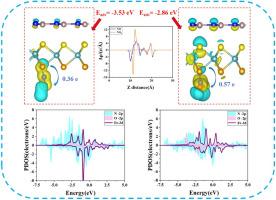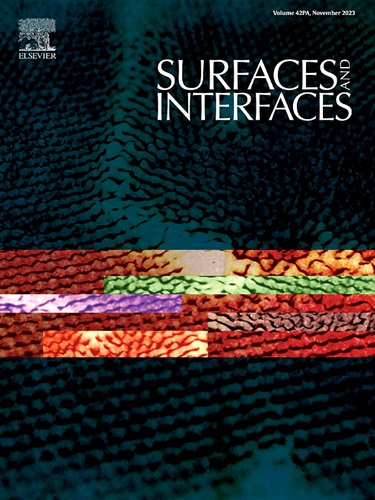嵌入过渡金属(铜、铁和锰)原子的 GaN@MoSSe 异质结构检测有害气体(NO、NO2):DFT 研究
IF 5.7
2区 材料科学
Q2 CHEMISTRY, PHYSICAL
引用次数: 0
摘要
由于氮氧化物和二氧化氮等空气污染物对环境和人类健康的有害影响,监测和识别这些污染物至关重要。本研究采用 PBE + U 函数的密度泛函理论(DFT)研究了氮氧化物和二氧化氮在过渡金属(TM)掺杂的 GaN@MoSSe 异质结构上的吸附和传感性能。研究分析了吸附能、电荷转移、电子局域函数、电荷密度差、自旋密度、带隙和态密度。研究结果表明,掺杂 TM 原子后,会发生从物理吸附到化学吸附的转变。此外,当表面掺入铜、铁和锰原子时,与气体吸附有关的行为也会得到显著改善。带隙及其变化会导致表面导电率的变化,从而影响吸附系统对气体的敏感性。特别是 CuGa-GaN@MoSSe 和 FeGa-GaN@MoSSe 系统,由于它们的带隙显著减小,对 NO 的气体灵敏度有所提高。与此同时,CuSe-MoSSe@GaN、CuGa-GaN@MoSSe、FeGa-GaN@MoSSe 和 MnGa-GaN@MoSSe 系统也显示出对 NO2 更强的传感能力。这项工作为探索 TM-GaN@MoSSe 异质结构在气体传感中的潜在应用提供了宝贵的理论见解。本文章由计算机程序翻译,如有差异,请以英文原文为准。

Detection of harmful gases (NO, NO2) by GaN@MoSSe heterostructures embedded with transition metal (Cu, Fe and Mn) atoms: A DFT study
Monitoring and identifying air pollutants, such as NO and NO2, is crucial due to their detrimental impact on both the environment and human health. This work employs density functional theory (DFT) with the PBE + U functional to investigate the adsorption and sensing performance of NO and NO2 on transition metal (TM)-doped GaN@MoSSe heterostructures. The adsorption energy, charge transfer, electron localization functions, charge density difference, spin density, band gaps and density of states are analyzed. The findings reveal that a transition from physisorption to chemisorption occurs after TM atoms doping. Also, when the surface is embedded with Cu, Fe and Mn atoms, there is a significant improvement in the behavior related to gas adsorption. The bandgap and its variations lead to the change in surface electrical conductivity, thereby affecting the gas sensitivity of the adsorption system. Particularly, the CuGa-GaN@MoSSe and FeGa-GaN@MoSSe systems exhibit improved gas sensitivity toward NO due to their significant band gap reduction. Meanwhile, the CuSe−MoSSe@GaN, CuGa-GaN@MoSSe, FeGa-GaN@MoSSe and MnGa-GaN@MoSSe systems also demonstrate enhanced sensing capabilities for NO2. This work offers valuable theoretical insights for exploring the potential applications of TM-GaN@MoSSe heterostructures in gas sensing.
求助全文
通过发布文献求助,成功后即可免费获取论文全文。
去求助
来源期刊

Surfaces and Interfaces
Chemistry-General Chemistry
CiteScore
8.50
自引率
6.50%
发文量
753
审稿时长
35 days
期刊介绍:
The aim of the journal is to provide a respectful outlet for ''sound science'' papers in all research areas on surfaces and interfaces. We define sound science papers as papers that describe new and well-executed research, but that do not necessarily provide brand new insights or are merely a description of research results.
Surfaces and Interfaces publishes research papers in all fields of surface science which may not always find the right home on first submission to our Elsevier sister journals (Applied Surface, Surface and Coatings Technology, Thin Solid Films)
 求助内容:
求助内容: 应助结果提醒方式:
应助结果提醒方式:


